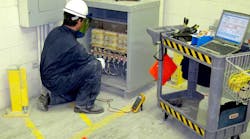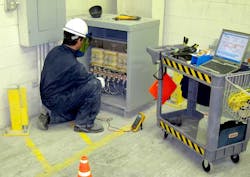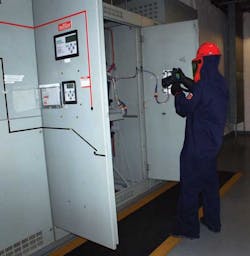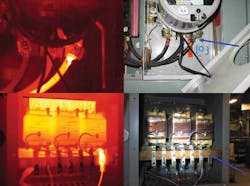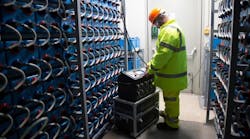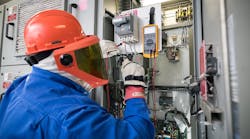Thermal imaging technology that flags possible electrical problems before they fully form and wreak havoc clearly demonstrates that heat generates light. But if light is also defined as the unvarnished truth, that may only be accurate in the purely physical sense.
Used competently and intelligently, infrared imaging (IR) used to pinpoint abnormally high or rising heat from resistance in electrical circuitry sheds bright light on foreknowledge that can save lives, money, and remorse. Like any tool, however, infrared thermography is only as good as the operator. Deploying the technology improperly, inaccurately interpreting the raw information it produces, and even failing to create an action plan that supports it can render results confusing at best or useless at worst.
Those red flags matter more as plummeting prices on IR imaging devices lead more of the technology’s beneficiaries to consider going the DIY route. Now capable of buying $1,000 IR cameras, facilities can opt to bring more thermal imaging in-house and rely less on thermography services. Under the right circumstances, that may be more feasible. But the technology requires both operator expertise and a game plan for using it. In trained hands — and when integrated into a broader predictive and preventive electrical maintenance program — it can be used to get out in front of costly electrical breakdowns.
The wild card, though, is confidence. Without it — certainty that measurements are accurate/ correctly interpreted and that decision makers will faithfully act on the conclusions — thermal imaging may yield little more than a set of pretty pictures.
Capturing reality
The first step to instilling that confidence is obtaining accurate images. New-generation IR cameras may be easier to use and produce better technical images, but they still demand a user who knows how to capture revealing images. Accurately orienting and aiming the device, correcting for conditions that can provide false readings, and fine-tuning the camera controls lay the groundwork for trustworthy data.
That’s a point thermographers like Robert Madding, PhD, try to drive home as they survey the thermal imaging landscape. Madding, president of RPM Energy Associates, LLC, and technical director of Greensboro, N.C.-based United Infrared’s ElectricIR electric thermographer network, hails the emergence of better and more affordable imaging devices. They may make it easier to spot a problem, but capturing true images and judging cause and severity of apparent problems falls to the seasoned imaging technician.
“You have to know as much about what you’re looking at as what you’re looking with,” says Madding, who has 40 years of field and teaching experience in thermography. “These advanced imaging devices can simply make it easier to get the wrong answer sometimes. With IR images, some users can easily fall into the trap of thinking they know what they’re viewing. They just don’t know what they don’t know.”
Reliable images start with accurate readings of heat that can be indicative of problems along a spectrum of severity. But those readings, Madding notes, can be easily thrown off by not accounting for heat’s very nature and transient conditions that can mask or obscure reality. Common mistakes inadequately trained imagers make, he says, may include taking readings through cabinet covers and doors; not controlling for target emissivity and reflectivity that can produce false readings; not factoring in heat from cabinet and motor heaters; and failing to understand how target distance and angle impact readings.
“Thinking that your IR camera sees through metal covers is a terribly incorrect fallacy,” he cautions. “Covers must be removed and cabinets opened unless they’re outfitted with IR windows, and not understanding spatial resolution will lead to incorrect temperature measurements. One can see a hot spot that is too small to get an accurate measurement.”
Accurate imaging depends on the ability to take readings that clearly reveal glaring temperature differentials or demonstrate progressive changes in heat over time. Comparative, not absolute, temperatures are key to isolating problem areas. Imagers must be comprehensive and thorough in their scanning procedures, taking care to capture complete images of the target area that definitively show abnormal heat.
“You need equipment to run under normal operating conditions for thermal imaging to be meaningful,” reiterates Marc Wild, a certified IR thermographer with ThermoTest, a Fishkill, N.Y., provider of IR thermography services. “With infrared you can pick up a fault very easily, for example, an overloaded circuit, imbalanced load, or loose connection. However, you need to have an understanding of how the equipment is supposed to function to interpret if it is a problem or not.”
Wild also emphasizes the importance of getting a focused image when recording an infrared problem. “Otherwise, your temperature reading will be highly inaccurate,” he says. “Get a clear image composition by standing close but within a safe distance. If you are too far away, you will also measure the temperature incorrectly. Everything emits radiation, so be careful of reflections, which will give false temperature readings. Stand on an angle to the target, and remember — if it moves when you do, it is a reflection.”
Relaying findings
Accurate thermal measurements are clearly essential, but how they’re gathered, compiled, and presented for action is equally important. For maximum utility, experts say, thermal imaging should take the form of a regular and routine endeavor that starts with a baseline assessment.
Initial readings will identify immediate problems that demand quick, corrective action. But their value also lies in creating a snapshot of conditions at a point in time that can be monitored for changes over time. Incorporated into a formal and comprehensive thermal imaging report, the findings should be framed to give decision makers clear documentation needed to justify expenditures.
The city of Grosse Point Farms, Mich., has deepened its reliance on thermal imaging to help spot trouble in aging generators, switchgear, and other electrical equipment used to operate a municipal water plant and sewage pumping station. Scott Homminga, the city’s water superintendent, says professional thermal imaging services provided by Facility Results, Plymouth, Mich., replaced crude attempts years ago to capture thermal images of critical equipment. Lacking a staff skilled in electrical maintenance and troubleshooting, Homminga says the thermal imaging services have proven valuable.
“It’s helped us get a handle on what areas we need to address,” Homminga says. “We’ve used the thermal imaging reports as a basis for quite a few upgrades.”
Although exact report content differs by provider, elements of a strong IR thermography report generally include a detailed description of the equipment tested, good image reproduction that clearly show problems, a description of the problem, testing conditions, a severity ranking based on some sort of color-coded problem-severity scale, and recommended actions.
Ron Salome, owner of Power Quality Consulting, a Powell River, B.C., Canada, thermal imaging services provider, says one noteworthy element of a strong report involves displaying an IR image next to the corresponding digital image of the equipment. A good IR image will clearly show a “problem” temperature and a nearby “reference” temperature. The resulting differential temperature is then dissected in terms of the possible explanations, a likely conclusion, and recommended actions.
“Just because something is hot doesn’t necessarily mean it’s a problem,” says Salome, noting that most software programs that come with IR cameras can be modified, which might make the situation appear worse than it really is.
Because the imager’s skill and quality/condition of testing equipment are so essential to accurate readings, some service providers advise referencing those factors as well.
“Information on the camera itself, the model number, processor type, date of last calibration, resolution, etc., provides the basis for knowing how strong the documentation is,” says Bryan Rupert, electrical safety consultant with Facility Results. “A camera that’s out of calibration can miss a lot of temperature variances, producing images that look like Swiss-cheese.”
Camera, pictures, now… action
But even the most objectively accurate results are meaningless unless an action plan is in place. Programs organized around thermal imaging are best deployed with the full participation and knowledge of an organization’s different layers of responsibility and expertise.
Imaging experts suggest their work should be buttressed by a set of fairly rigid action triggers. In the initial stages, definitive guidelines for repair or replacement should be formulated to minimize uncertainty. A thermal imaging consultant can contribute by showing clear examples of imaging’s predictive value and reasserting the value of preventive maintenance.
“Recommended actions should be derived by the predictive and conditions-based maintenance team — one that includes representatives from maintenance, operations, engineering, and management,” Madding advises.
A risk calculation can vary by the nature of the facility or system and impact how (and how frequently) thermal imaging is performed. Best integrated into an ongoing troubleshooting and maintenance program, thermal imaging can be conducted on a range of timetables that may dictate surveys that constantly rotate through assets.
Mission-critical environments where equipment failure can lead to costly production delays or even life-threatening service interruptions may call for more frequent or thorough testing. That may be the case in environments like hospitals and airports, Salome says, where de-energized maintenance and assessment are harder to conduct.
Manufacturing environments may warrant more frequent inspections because they may be more prone to failure. Highly susceptible to by-product infiltration, air-cooled transformers and circuit breaker panels may be at especially high risk of failure, Salome notes, leading to costly downtime that could be averted with the aid of regular targeted thermal inspections.
However testing is scheduled, being comprehensive may deliver particular value. Because some of thermal imaging’s value is derived from the ability to spot problems that may worsen over time and warrant attention before problems become critical, Rupert says testing should encompass as broad a swath of the system as possible.
“A lot go out and document only areas where there are known anomalies,” he says. “All of the components should be benchmarked.”
A long-term imaging plan can be based on factors including reliability demands, component-specific findings, budget considerations, manufacturer recommendations, and even insurer requirements.
“At least annually is probably good to shoot for in general, and doing half of a facility’s equipment every year can be a good guide,” Rupert says.
Bringing it home
Schedules can gain flexibility based on whether and how much a facility wants to bring thermal imaging in-house. Lower-priced IR cameras make that possible, opening the door to more frequent inspections and closer monitoring of suspect areas outside of a consultant’s imaging schedule.
In that event, training is essential and generally available. But a paradox of less expensive, more advanced imaging devices may be a reluctance to invest time and money in adequate training.
“One shouldn’t compare IR camera cost and training cost, though it’s natural to do so,” Madding says. “Management is much more willing to spend a couple thousand dollars on IR training when they paid $35,000 for an IR camera than they are when they paid $3,500 or so.”
The facilities manager for Lotus Engineering, Inc., an Ann Arbor, Mich., automotive equipment testing company, has been shopping for an IR camera to increase the margin of electrical safety on-site and spot trouble in electrical equipment that runs dynamometers and other testing equipment. Facility Results has been providing periodic inspection services for the firm, but Dave Krisko says a company-owned camera might provide the flexibility to forestall a costly breakdown in the middle of a critical customer testing session.
“Before we run a test on a client’s part, we could bring the equipment up to load, take some pictures, and make sure there’s not a hot spot, say, on a busway joint,” he says. “We could tell if something’s wearing or a connection needs to be re-torqued or cleaned, and then fix it before running a permanent test.”
Krisko says he’s confident that the $1,000 camera he was eyeing would meet his needs, and that a staffer with solid electrical knowledge would be capable of operating it and accurately interpreting thermal images. But some experts say operations like Lotus need to be aware of the less obvious pitfalls of starting down the DIY road with an IR camera purchase. An underappreciated one, says Salome, is that a device is only part of a necessarily rigorous thermal imaging program.
“The problem of doing it yourself is that the camera ends up sitting on a shelf,” says Salome, who goes on to point out that other problems can crop up if there’s a lapse in training or if new employees are assigned to use the equipment without initially being trained.
But then again, relying totally on an outside imaging provider isn’t a guarantee of smooth sailing, Salome adds. Maintenance issues, especially of the predictive and preventive type that can involve big expenditures based on subjective analyses, could lapse into territorial and political disputes. When a third party enters the picture, that dynamic can become even more complex.
“If a thermal imager comes in and finds a problem, shows it to management, and management asks maintenance what’s wrong and why hadn’t
they found it, that can end up reflecting badly on them,” Salome says. “There needs to be cooperation between the thermal people and the maintenance staff.”
Zind is a freelance writer based in Lee’s Summit, Mo. He can be reached at [email protected].
SIDEBAR: Full Spectrum Testing
In addition to infrared, other tools can smoke out electrical problems.
Infrared thermal imaging is a powerful predictive maintenance tool for electrical applications, but it’s not the only one. Vibration analysis and ultrasonic testing can pick up early warning signs of failure, and can help validate or supplement thermal imaging. Some thermal imaging providers looking to ascertain the severity of problems with more confidence say they’re incorporating these and other measurement tools into their testing regimens.
“We advise using at least three technologies to do diagnostic work,” says Bryan Rupert, electrical safety consultant with Facility Results, Plymouth, Mich. “Ultrasonic testing done with a trained ear using non-contact earphones can pick up noises that can precede failure, such as arcing in a breaker, that allow you to be more predictive. And then once you think you’ve found an anomaly, a volt-ohm multimeter drop test can help further diagnose the problem. Some of these other inexpensive technologies can yield some high predictive value.”
Marc Wild, a certified thermographer with ThermoTest, Fishkill, N.Y., says the company can include vibration and ultrasound testing as a complement to its primary thermal imaging services.
“An IR test can initially pick up problems in some things such as an electrical motor; then you can confirm the defects with vibration analysis,” he says. “An example of where it can be used in conjunction with thermal imaging might be for early detection of mechanical fatigue and breakdown.”
The ease of using tools, such as an ultrasonic probe, make the prospect of complementing thermal imaging attractive in some environments, says Ron Salome, owner of Power Quality Consulting, Powell River, B.C., Canada. Ultrasonic testing can reliably pick up arcing and corona in high-voltage systems, making it a reliable “secondary tool.”
